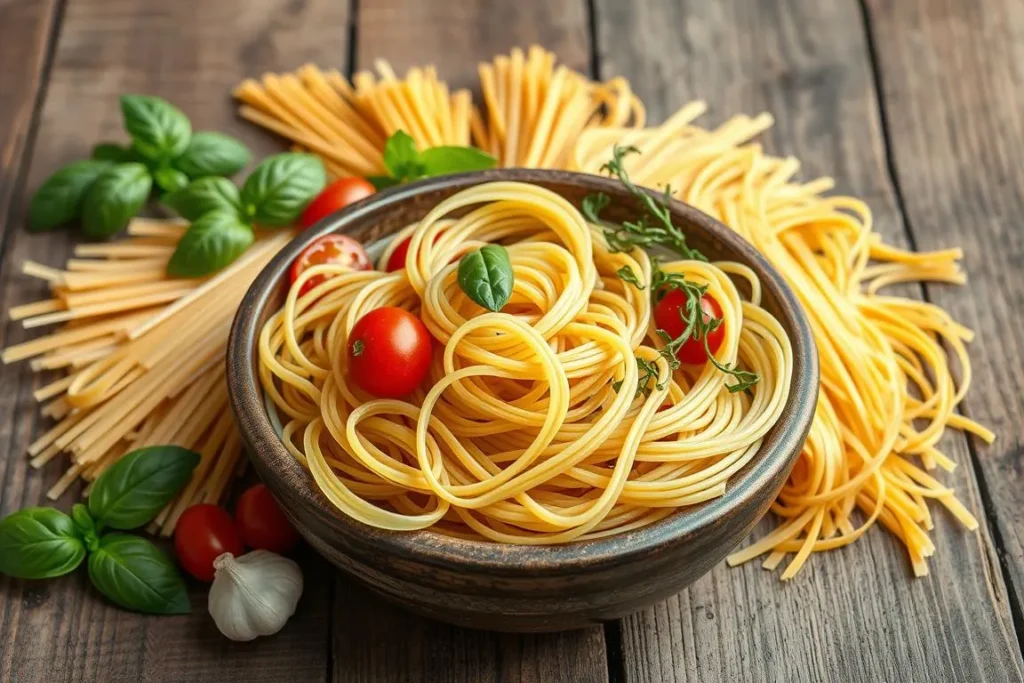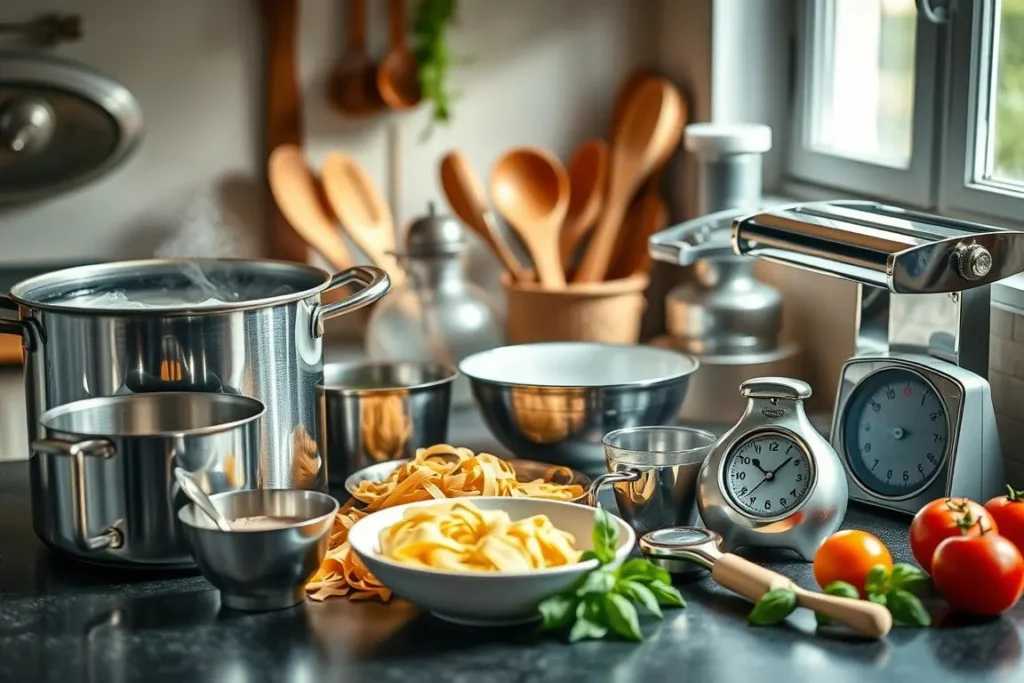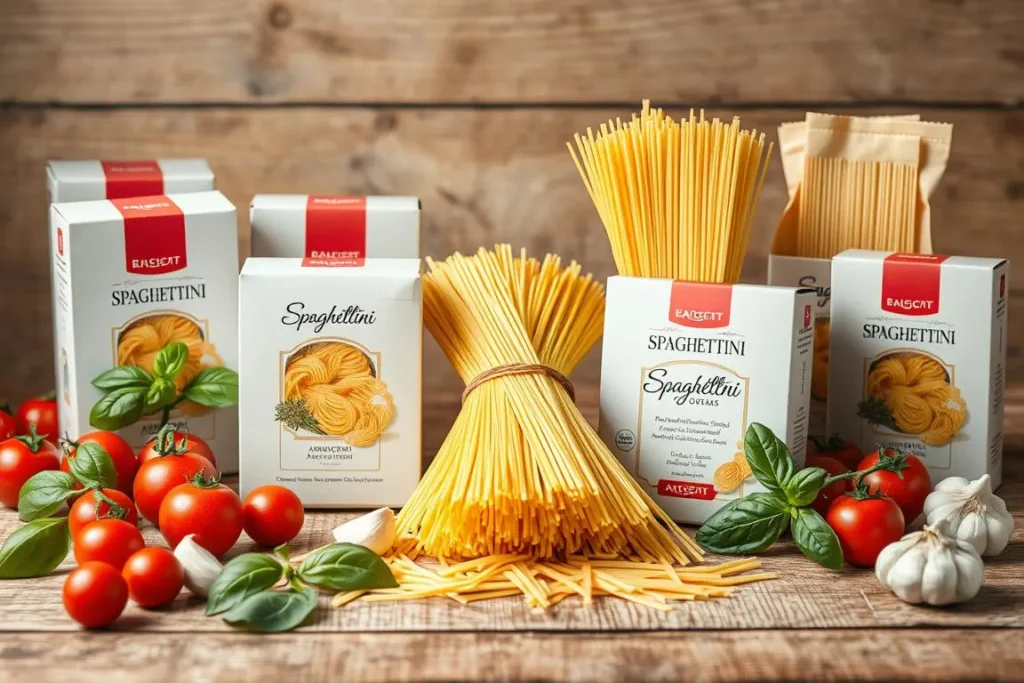The first time I tried cooking thin spaghetti, it was a mess. The delicate strands turned into a clumpy mess. My Italian grandmother would have been sad.
But after years of practice, we got it right. We learned how to cook spaghettini pasta with care.
Cooking angel hair pasta or vermicelli pasta needs a special touch. These thin pasta types need respect and skill. We’ll show you how to make spaghettini that will wow everyone.
Making perfect thin spaghetti is more than just boiling water. It’s about knowing the right texture and timing. Our guide will help you go from beginner to pro.
In this guide, we’ll cover everything from picking the best ingredients to cooking techniques. You’ll learn how to make spaghettini that’s always just right. Get ready to impress your family and friends with your pasta dishes.
Understanding Spaghettini Pasta and Its Unique Characteristics
Pasta fans know spaghettini as a fancy italian pasta type. It’s thicker than angel hair but thinner than regular spaghetti. This makes it special for those who love cooking and eating.

Spaghettini is a delicate noodle that needs careful handling. We’ll see why these noodles are unique and loved by many.
Differences Between Spaghettini and Other Thin Pasta Types
Spaghettini is special because of its own traits:
- Diameter is between 1.5-2 millimeters
- Thinner than regular spaghetti
- Heavier than angel hair pasta
- Has a smoother texture than other thin noodles
Why Choose Spaghettini Over Regular Spaghetti
Spaghettini has perks for pasta lovers. It cooks fast and holds sauce well. This makes it great for light dishes.
The Perfect Thickness for Delicate Sauces
Spaghettini is best with olive oil-based and light cream sauces. Its thinness lets sauces cover each strand well. This creates a perfect mix of pasta and sauce.
Essential Equipment for Cooking Fine String Pasta

Preparing perfect spaghettini needs the right tools. Our guide will show you what you need to make your pasta better.
Quality kitchen tools are key for tasty pasta. A strong pasta pot is the base. Look for pots with:
- Heavy bottom for even heat
- Large capacity to avoid overcrowding
- High sides to stop water from boiling over
The colander is also very important. Stainless steel colanders are durable and drain well. When picking a colander, think about these things:
- Stable base for safe draining
- Wide handles for easy holding
- Perforated design for fast water removal
We suggest more tools to make cooking easier:
- Long-handled pasta spoon
- Digital kitchen scale
- Instant-read thermometer
- Timer with exact times
The right tools make your pasta cooking better. Each tool is important for perfect spaghettini.
Selecting High-Quality Spaghettini pasta Brands
Choosing the right spaghettini can make your pasta experience better. It’s important to know how to pick the best. This way, you’ll become an expert at selecting pasta.

Top Italian Pasta Manufacturers
- De Cecco: Known for consistent quality and traditional production methods
- Barilla: A global leader in pasta manufacturing
- Rummo: Specialized in artisanal pasta production
- Pastificio Felicetti: Renowned for premium organic wheat selections
What to Look for on the Package
High-quality spaghettini has certain package details. Here’s what to check:
- Durum wheat semolina as the primary ingredient
- Italian origin certification
- Bronze-cut texture indication
- Protein content (higher is better)
Price vs. Quality Considerations
Expensive pasta doesn’t always mean better taste. Look for a balance between price and quality. Brands priced between $3-$7 usually offer the best value.
Investing in quality spaghettini supports traditional pasta-making. It also ensures a great taste experience.
Water to Pasta Ratio: Getting It Right
Mastering the perfect pasta cooking water ratio is key for delicious spaghettini. Getting the water measurement right can make or break your dish.
When cooking spaghettini, follow these water ratio guidelines:
- Use about 4-6 quarts of water per pound of pasta
- Make sure the pot is big enough for the pasta to move freely
- Fill the pot about 3/4 full with water
The perfect pasta ratio is not just about how much water. It’s about creating the right environment for your spaghettini. Too little water can cause sticking. Too much can water down the flavor.
Professional chefs suggest:
- Use a wide, deep pot
- Keep the water boiling
- Stir occasionally to stop clumping
Pro tip: Don’t rinse your pasta after cooking. The starchy pasta cooking water helps sauces stick better to the noodles.
By using these water measurement tips, you’ll make your spaghettini amazing.
The Perfect Salt Balance for Cooking Thin Spaghettini pasta
Salting pasta water is an art that can make a simple dish into a masterpiece. The right amount of salt makes spaghettini taste better, making each bite more enjoyable.
Salt is key in making your pasta taste great. Choose the right salt and add it at the best time for the best flavor.
Selecting the Best Salt for Cooking Pasta
- Kosher Salt: Our top recommendation for salt for cooking pasta
- Sea salt with larger, coarser grains
- Avoid table salt, which can make the water taste too harsh
Mastering the Salt Timing
The secret to perfect salting pasta water is timing. Follow these guidelines:
- Wait until the water reaches a rolling boil
- Add salt before inserting the pasta
- Use approximately 1-2 tablespoons of salt per pound of pasta
A good rule of thumb is to make your pasta water taste like the sea. This might seem like a lot of salt, but most will remain in the water. The pasta only absorbs a small amount, creating a perfectly seasoned dish from the inside out.
Professional chefs know that salt is not just about making food salty – it’s about bringing out the natural flavors. By mastering the art of salting pasta water, you’ll make meals that taste like they’re from a restaurant, right in your own kitchen.
Proper Boiling Techniques for Delicate Strands
Mastering pasta boiling for spaghettini needs precision and care. Thin pasta strands need special attention to avoid breaking. We’ll show you how to cook delicate spaghettini like a pro.
Start with a big pot for spaghettini. Use at least 4-6 quarts of water for one pound of pasta. This extra space stops the thin strands from sticking together.
- Select a wide, deep pot with plenty of room
- Use high heat to bring water to a rapid boil
- Add salt after water reaches full boil
- Stir gently to separate spaghettini strands
Cooking thin pasta needs careful timing. Spaghettini cooks faster than regular spaghetti, taking 6-8 minutes. Watch it closely and test for al dente by tasting a strand. The best technique is to remove it just before it’s too soft.
Our top tip for avoiding breakage: lower the pasta into the water slowly and gently. Don’t drop the whole bundle at once. Use tongs or a pasta fork to submerge the strands carefully, letting them soften and sink naturally.
Determining the Ideal Cooking Time
Cooking perfect spaghettini needs precision and detail. Getting al dente pasta is an art that makes a simple dish special. The right pasta cooking time is key to a great meal.
Knowing how to check pasta doneness is important for home chefs. Spaghettini cooks faster than thicker pasta, so timing is very important.
Testing for Al Dente Perfection
To check if pasta is perfect, try these methods:
- Bite test: Remove a strand and bite into the center
- Check for a slight resistance when chewing
- Look for a tiny white dot in the pasta’s core
- Total cooking time typically ranges between 6-8 minutes
Common Timing Mistakes to Avoid
Many home cooks struggle with pasta cooking time. Here are mistakes to avoid:
- Overcooking leads to mushy, unappetizing pasta
- Not stirring can cause uneven cooking
- Ignoring package instructions
- Failing to test pasta during cooking process
Pro tip: Always set a timer and start checking your spaghettini one minute before the recommended cooking time. This ensures you capture that perfect al dente texture every time.
Best Sauces to Pair with Spaghettini pasta
Choosing the right sauce is key for spaghettini. Our guide to light pasta sauces will help you make tasty thin pasta recipes. These recipes will show off the pasta’s delicate nature.
For spaghettini sauce pairings, go for lighter, more refined options. These should not overpower the pasta’s subtle texture. The goal is to find balance and flavors that go well together.
- Olive Oil and Garlic Sauce: A classic choice that lets spaghettini’s delicate structure shine
- Fresh Tomato Marinara: Lightweight and bright, perfect for thin pasta recipes
- Herb-Infused Butter Sauce: Delicate and aromatic, ideal for light pasta sauces
Cream-based sauces can work, but keep them light and not too thick. A subtle carbonara or a gentle alfredo can make your spaghettini special without overwhelming it.
Seafood-based sauces are great with spaghettini. Try a light lemon-butter sauce with fresh shrimp or a delicate white wine reduction with clams. This will make your meal elegant.
- Avoid heavy meat sauces
- Prioritize fresh, high-quality ingredients
- Keep sauce portions proportional to pasta
Try different spaghettini sauce pairings to find your favorite. The aim is to make the pasta better, not hide it.
Tips for Preventing Pasta from Sticking
Cooking perfect spaghettini needs skill and knowledge. It’s key to prevent pasta from sticking for a great meal at home.
Our tips will help you make smooth, separated spaghettini every time. Sticky pasta can mess up a good dish. But with the right steps, each strand will stay perfectly separate.
Oil Usage Guidelines
Many home cooks use olive oil. But we suggest a smart way to avoid pasta sticking:
- Add oil after cooking, not during boiling
- Use just enough oil to avoid a greasy mess
- Choose high-quality extra virgin olive oil for the best taste
Stirring Techniques
Stirring right is key in non-stick pasta techniques. Here’s how to do it:
- Stir pasta right after adding it to boiling water
- Use a long wooden or metal spoon
- Stir gently but keep going for the first 2-3 minutes
- Keep the water boiling all the way through cooking
Follow these tips to make perfectly separated spaghettini. It’s ready for your favorite sauce.
Proper Draining and Reserving Pasta Water
Learning how to drain pasta is key for making great spaghettini dishes. The way you drain and use the cooking liquid can greatly affect your dish.
Our method for draining pasta includes a few important steps. First, use a big colander for quick draining. Don’t shake it too hard, as it can damage the spaghettini.
- Place the colander in the sink before pouring hot pasta
- Drain quickly to prevent overcooking
- Reserve 1 cup of pasta cooking liquid before complete drainage
Reserving pasta water is a trick used by top chefs. It makes sauces smooth and clingy. The starches in the water help thicken the sauce.
Keep the reserved pasta water in a cup or container that can handle heat. It should be hot and a bit cloudy. This means it’s full of starches that add flavor. Use it to adjust the sauce’s thickness, making it stick to the pasta well.
- Capture pasta water before complete drainage
- Store in a heat-resistant container
- Add gradually to achieve desired sauce texture
Top chefs say to use the pasta water right after draining for the best taste. The warmer it is, the better it will mix with your sauce.
Serving and Plating Techniques
Learning how to plate pasta can turn a simple meal into a feast for the eyes. Serving spaghettini right is key. We’ll share some tips to make your pasta look as good as it tastes.
First, pick the right tools. A wide, shallow bowl is best for spaghettini. It lets the pasta spread out and show off its beauty.
- Use tongs to create gentle, height-based twirls
- Center the pasta in the middle of the plate
- Leave some negative space around the edges
Temperature is important when serving spaghettini. Warm your plates before serving. A quick 30-second warm-up in the oven helps keep the pasta hot.
Garnishing is an art. Sprinkle fresh herbs like basil or parsley over the pasta. A bit of Parmigiano-Reggiano adds flavor and looks good too.
- Use microgreens for elegant garnish
- Add a drizzle of extra virgin olive oil
- Consider color contrast with your garnishes
Don’t forget about portion size. A good serving of spaghettini is about 2 ounces per person. This keeps the plate balanced and beautiful.
Conclusion
Our spaghettini pasta cooking guide shows that making perfect thin pasta needs care and practice. We’ve looked at key techniques that make pasta cooking an art. Choosing good Italian brands, knowing water ratios, and salt balance all help make a great meal.
Mastering thin pasta is more than just following recipes. It’s about knowing the special techniques that make your cooking stand out. By using the right boiling methods, timing, and sauce choices, you can make food like a pro. The secret is patience, paying attention to details, and trying new things.
As you keep learning to make pasta, remember that every dish starts with basic skills. Try out the methods we talked about, like water temperature and draining. Soon, you’ll make spaghettini that will wow your family and friends. Keep learning, and don’t be scared to make these techniques your own.
Cooking amazing spaghettini is a journey that never ends. With practice, love, and the right knowledge, you’ll turn simple ingredients into unforgettable meals. These meals will honor the rich tradition of Italian cooking.
FAQ
What is the difference between spaghettini and regular spaghetti?
Spaghettini is thinner than regular spaghetti. It cooks faster and works well with light sauces. Regular spaghetti is about 2.1-2.3 mm thick. Spaghettini is thinner, making it great for fancy Italian dishes.
How long should I cook spaghettini pasta?
Cook spaghettini for 4-6 minutes. Check the package for exact time. Start testing for doneness at 4 minutes. It cooks quickly, so watch it closely.
Can I use spaghettini for heavy cream sauces?
No, we don’t suggest it. Spaghettini is best with light sauces. Heavy cream sauces are too much for its thin strands. Use thicker pasta for cream sauces.
What is the ideal water-to-pasta ratio when cooking spaghettini?
Use 4-5 quarts of water for every pound of spaghettini. This prevents sticking and ensures even cooking. Choose a big pot for easy movement.
Should I add oil to the pasta water?
No oil in the water. Oil stops sauce from sticking to the pasta. Use lots of water and stir to prevent sticking.
How can I prevent spaghettini from breaking while cooking?
Gently add spaghettini to boiling water. Push it down slowly as it softens. Use a long fork and avoid stirring too much. Once it’s mostly submerged, it won’t break as easily.
What type of salt should I use for pasta water?
Use coarse sea salt or kosher salt. They dissolve well and taste better than fine salt. Add 1-2 tablespoons per pound of pasta after the water boils.
How do I know when spaghettini is cooked perfectly?
Test for doneness by biting into a strand at 4 minutes. It should be slightly firm but not raw. The color should be even, without a white core.
